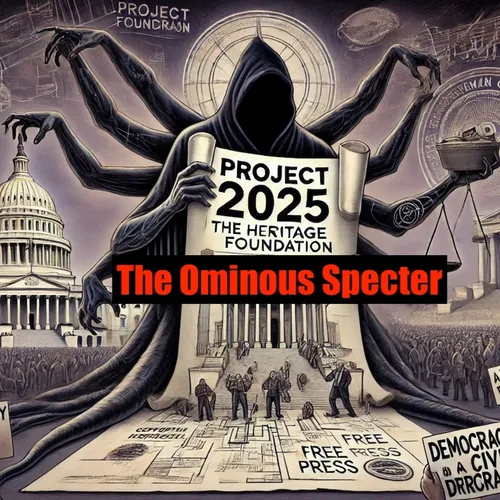Centralized Power or Democratic Decay: The Looming Threat of Project 2025
- Author
- Quiet.Please
- Published
- Sun 18 May 2025
- Episode Link
- https://www.spreaker.com/episode/centralized-power-or-democratic-decay-the-looming-threat-of-project-2025--66141834
As I delve into the intricacies of Project 2025, a sense of unease settles in, not just because of the far-reaching implications it holds for American governance, but also due to the sheer ambition and controversial nature of its proposals. This initiative, spearheaded by conservative organizations and thinkers, aims to fundamentally reshape the federal government, centralizing power in the White House and challenging long-standing principles of checks and balances.
At the heart of Project 2025 is the unitary executive theory, an expansive interpretation of presidential power that seeks to place the entire executive branch under direct presidential control. This vision is not new; it has roots in the Reagan administration and has been bolstered by conservative justices, the Federalist Society, and the Heritage Foundation. However, the current iteration takes this concept to unprecedented heights. As Kevin Roberts, a key proponent, has stated, all federal employees should answer directly to the president, eliminating the independence of agencies like the Department of Justice, the FBI, the Federal Communications Commission (FCC), and the Federal Trade Commission (FTC)[4].
One of the most striking aspects of Project 2025 is its plan for the Department of State. Kiron Skinner, who authored the State Department chapter, advocates for the dismissal of all leadership roles within the department before January 20, 2025. These positions would be filled by ideologically vetted leaders appointed to acting roles, bypassing the need for Senate confirmation. Skinner's rationale is stark: she believes most State Department employees are too left-wing and need to be replaced by those more loyal to a conservative president. When questioned about specific instances where State Department employees obstructed Trump policies, Skinner admitted she could not provide any examples[4].
This approach is not isolated to the State Department. Project 2025 targets the independence of various federal agencies, which have historically operated with a degree of autonomy to ensure they are not swayed by political whims. Agencies like the FCC, FTC, Equal Employment Opportunity Commission (EEOC), and National Labor Relations Board (NLRB) are designed to be quasi-legislative or quasi-judicial bodies, shielded from presidential interference by bipartisan commissions. The Supreme Court has upheld this independence in landmark cases such as *Humphrey’s Executor v. United States*[5].
However, Project 2025 seeks to overrule such precedents, allowing the president to remove independent agency commissioners at will if they do not align with the president’s agenda. This would fundamentally alter the balance of power, giving the president unprecedented control over these agencies. The White House’s Office of Information and Regulatory Affairs (OIRA) would also be empowered to review, revise, or block rules and significant guidance issued by these agencies, further eroding their independence[5].
The potential implications of these changes are profound. By centralizing power and dismantling the checks and balances that have long defined American governance, Project 2025 could lead to what critics describe as an "imperial presidency." This would enable a president to implement policies with minimal oversight, potentially undermining democratic norms and the rule of law. As the American Civil Liberties Union (ACLU) has noted, such a reconfiguration of executive power would have immense and far-reaching consequences, particularly if it aligns with the re-election of a president like Donald Trump[1].
The plan also includes significant workforce reductions, with estimates suggesting up to 1 million federal workers could be terminated. This would not only decimate the federal workforce but also severely impact the functioning of various government agencies, leading to potential inefficiencies and gaps in...
